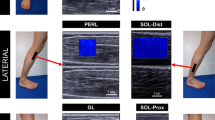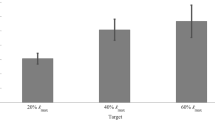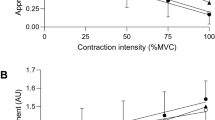Abstract
The ability to modulate the mechanical properties of our limbs contributes to our ability to interact with the physical world in a consistent and predictable manner. An individual joint’s contributions to whole limb mechanics can be quantified by its joint impedance, which characterizes the torque generated about a joint in response to external perturbations of position. A number of studies have estimated joint impedance during movement and have shown that it can be much lower than it is during posture. However, the mechanisms contributing to these differences remain unknown partly because conditions known to affect impedance, including muscle activation and joint angles, have not been carefully controlled across studies. The goal of this study was to contrast knee impedance during continuous volitional movements with that during maintained postures spanning a similar range of joint angles and muscle activations and to explore physiological mechanisms likely to contribute to the observed differences. We found that knee impedance was substantially lower during movement than during matched postural tasks, even for matched muscle activations. At times, the impedance during movement was even lower than that measured during isometric tasks with no volitional muscle activity. These decreases in impedance could be attributed in part to reduced stretch reflexes during movement and to an effect of movement itself on reducing knee impedance.








Similar content being viewed by others
References
Barrett RS, Besier TF, Lloyd DG (2007) Individual muscle contributions to the swing phase of gait: an EMG-based forward dynamics modelling approach. Simul Model Pract Theory 15:1146–1155. doi:10.1016/j.simpat.2007.07.005
Bennett DJ, Hollerbach JM, Xu Y, Hunter IW (1992) Time-varying stiffness of human elbow joint during cyclic voluntary movement. Exp Brain Res 88:433–442. doi:10.1007/BF02259118
Borghese NA, Bianchi L, Lacquaniti F (1996) Kinematic determinants of human locomotion. J Physiol 494:863–879
Brooke JD, Collins DF, Boucher S, McIlroy WE (1991) Modulation of human short latency reflexes between standing and walking. Brain Res 548:172–178. doi:10.1016/0006-8993(91)91119-L
Brooke JD, Misiaszek JE, Cheng J (1993) Locomotor-like rotation of either hip or knee inhibits soleus H reflexes in humans. Somatosens Mot Res 10:357–364. doi:10.3109/08990229309028843
Collins DF, McIlroy WE, Brooke JD (1993) Contralateral inhibition of soleus H reflexes with different velocities of passive movement of the opposite leg. Brain Res 603:96–101. doi:10.3109/08990229309028843
de Vlugt E, Schouten AC, van der Helm FC (2003) Closed-loop multivariable system identification for the characterization of the dynamic arm compliance using continuous force disturbances: a model study. J Neurosci Methods 122:123–140 (pii:S0165027002003035)
Eilenberg MF, Geyer H, Herr H (2010) Control of a powered ankle-foot prosthesis based on a neuromuscular model. IEEE Trans Neural Syst Rehabil Eng 18:164–173. doi:10.1109/TNSRE.2009.2039620
Ettema GJ, Huijing PA (1994) Skeletal muscle stiffness in static and dynamic contractions. J Biomech 27:1361–1368. doi:10.1016/0021-9290(94)90045-0
Finley JM, Dhaher YY, Perreault EJ (2013) Acceleration dependence and task-specific modulation of short- and medium-latency reflexes in the ankle extensors. Physiol Rep 1:e00051. doi:10.1002/phy2.51
Forbes PA, Happee R, van der Helm FC, Schouten AC (2011) EMG feedback tasks reduce reflexive stiffness during force and position perturbations. Exp Brain Res 213:49–61. doi:10.1007/s00221-011-2776-y
Gomi H, Kawato M (1996) Equilibrium-point control hypothesis examined by measured arm stiffness during multijoint movement. Science 272:117–120. doi:10.1126/science.272.5258.117
Gomi H, Kawato M (1997) Human arm stiffness and equilibrium-point trajectory during multi-joint movement. Biol Cybern 76:163–171. doi:10.1007/s004220050329
Grey MJ, Pierce CW, Milner TE, Sinkjaer T (2001) Soleus stretch reflex during cycling. Mot Control 5:36–49
Ha KH, Varol HA, Goldfarb M (2011) Volitional control of a prosthetic knee using surface electromyography. IEEE Trans Biomed Eng 58:144–151. doi:10.1109/TBME.2010.2070840
Hansen AH, Childress DS, Miff SC, Gard SA, Mesplay KP (2004) The human ankle during walking: implications for design of biomimetic ankle prostheses. J Biomech 37:1467–1474. doi:10.1016/j.jbiomech.2004.01.017
Hoffer JA, Andreassen S (1981) Regulation of soleus muscle stiffness in premammillary cats: intrinsic and reflex components. J Neurophysiol 45:267–285
Hogan N (1984) Adaptive control of mechanical impedance by coactivation of antagonist muscles. IEEE Trans Autom Control 29:681–690. doi:10.1109/tac.1984.1103644
Hu X, Murray WM, Perreault EJ (2011) Muscle short-range stiffness can be used to estimate the endpoint stiffness of the human arm. J Neurophysiol 105:1633–1641. doi:10.1152/jn.00537.2010
Kearney RE, Hunter IW (1982) Dynamics of human ankle stiffness: variation with displacement amplitude. J Biomech 15:753–756
Kearney RE, Hunter IW (1990) System identification of human joint dynamics. Crit Rev Biomed Eng 18:55–87
Kearney RE, Stein RB, Parameswaran L (1997) Identification of intrinsic and reflex contributions to human ankle stiffness dynamics. IEEE Trans Biomed Eng 44:493–504. doi:10.1109/10.581944
Kearney RE, Lortie M, Stein RB (1999) Modulation of stretch reflexes during imposed walking movements of the human ankle. J Neurophysiol 81:2893–2902
Lakie M, Robson LG (1988) Thixotropic changes in human muscle stiffness and the effects of fatigue. Q J Exp Physiol 73:487–500. doi:10.1113/expphysiol.1988.sp003169
Lloyd DG, Besier TF (2003) An EMG-driven musculoskeletal model to estimate muscle forces and knee joint moments in vivo. J Biomech 36:765–776. doi:10.1016/S0021-9290(03)00010-1
Ludvig D, Kearney RE (2007) Real-time estimation of intrinsic and reflex stiffness. IEEE Trans Biomed Eng 54:1875–1884. doi:10.1109/TBME.2007.894737
Ludvig D, Perreault EJ (2012) System identification of physiological systems using short data segments. IEEE Trans Biomed Eng 59:3541–3549. doi:10.1109/TBME.2012.2220767
Ludvig D, Perreault EJ (2014a) The dynamic effect of muscle activation on knee stiffness. Conf Proc IEEE Eng Med Biol Soc 2014:1599–1602. doi:10.1109/EMBC.2014.6943910
Ludvig D, Perreault EJ (2014b) Task-relevant adaptation of musculoskeletal impedance during posture and movement. In: 2014 American Control Conference, pp 4784–4789. doi:10.1109/ACC.2014.6859185
Ludvig D, Cathers I, Kearney RE (2007) Voluntary modulation of human stretch reflexes. Exp Brain Res 183:201–213. doi:10.1007/s00221-007-1030-0
Ludvig D, Visser TS, Giesbrecht H, Kearney RE (2011) Identification of time-varying intrinsic and reflex joint stiffness. IEEE Trans Biomed Eng 58:1715–1723. doi:10.1109/TBME.2011.2113184
Maganaris CN, Paul JP (2000) Hysteresis measurements in intact human tendon. J Biomech 33:1723–1727. doi:10.1016/S0021-9290(00)00130-5
McIlroy WE, Collins DF, Brooke JD (1992) Movement features and H-reflex modulation. II. Passive rotation, movement velocity and single leg movement. Brain Res 582:85–93. doi:10.1016/0006-8993(92)90320-9
Mirbagheri MM, Barbeau H, Kearney RE (2000) Intrinsic and reflex contributions to human ankle stiffness: variation with activation level and position. Exp Brain Res 135:423–436
Morgan DL (1977) Separation of active and passive components of short-range stiffness of muscle. Am J Physiol 232:C45–C49
Mrachacz-Kersting N, Sinkjaer T (2003) Reflex and non-reflex torque responses to stretch of the human knee extensors. Exp Brain Res 151:72–81. doi:10.1007/s00221-003-1483-8
Perreault E, Hargrove L, Ludvig D, Lee H, Sensinger J (2014) Considering limb impedance in the design and control of prosthetic devices. In: Artemiadis P (ed) Neuro-robotics. Springer, Netherlands, pp 59–83
Pfeifer SM (2014) Biomimetic stiffness for transfemoral prostheses. ETH Zurich. doi:10.3929/ethz-a-010261188
Pfeifer S, Vallery H, Hardegger M, Riener R, Perreault EJ (2012) Model-based estimation of knee stiffness. IEEE Trans Biomed Eng 59:2604–2612. doi:10.1109/TBME.2012.2207895
Popescu F, Hidler JM, Rymer WZ (2003) Elbow impedance during goal-directed movements. Exp Brain Res 152:17–28. doi:10.1007/s00221-003-1507-4
Proske U, Morgan DL, Gregory JE (1993) Thixotropy in skeletal muscle and in muscle spindles: a review. Prog Neurobiol 41:705–721. doi:10.1016/0301-0082(93)90032-N
Proske U, Tsay A, Allen T (2014) Muscle thixotropy as a tool in the study of proprioception. Exp Brain Res 232:3397–3412. doi:10.1007/s00221-014-4088-5
Rack PM, Westbury DR (1974) The short range stiffness of active mammalian muscle and its effect on mechanical properties. J Physiol 240:331–350. doi:10.1113/jphysiol.1974.sp010613
Rouse EJ, Hargrove LJ, Perreault EJ, Kuiken TA (2012) Estimation of human ankle impedance during walking using the perturbator robot. In: Biomedical robotics and biomechatronics (BioRob), 2012 4th IEEE RAS & EMBS International Conference, pp 373–378. doi:10.1109/BioRob.2012.6290842
Sinkjaer T, Andersen JB, Larsen B (1996) Soleus stretch reflex modulation during gait in humans. J Neurophysiol 76:1112–1120
Stein RB, Gordon T (1986) Nonlinear stiffness–force relationships in whole mammalian skeletal muscles. Can J Physiol Pharmacol 64:1236–1244. doi:10.1139/y86-209
Tsuchiya T, Guth K, Kuhn HJ, Ruegg JC (1982) Decrease in stiffness during shortening in calcium activated skinned muscle fibers. Pflugers Arch 392:322–326. doi:10.1007/bf00581626
van der Helm FC, Schouten AC, de Vlugt E, Brouwn GG (2002) Identification of intrinsic and reflexive components of human arm dynamics during postural control. J Neurosci Methods 119:1–14. doi:10.1016/S0165-0270(02)00147-4
Westwick DT, Perreault EJ (2012) Estimates of acausal joint impedance models. IEEE Trans Biomed Eng 59:2913–2921. doi:10.1109/TBME.2012.2213339
Whitehead NP, Gregory JE, Morgan DL, Proske U (2001) Passive mechanical properties of the medial gastrocnemius muscle of the cat. J Physiol 536:893–903. doi:10.1111/j.1469-7793.2001.00893.x
Wiegner AW (1987) Mechanism of thixotropic behavior at relaxed joints in the rat. J Appl Physiol 62:1615–1621
Yang JF, Stein RB, James KB (1991) Contribution of peripheral afferents to the activation of the soleus muscle during walking in humans. Exp Brain Res 87:679–687. doi:10.1007/BF00227094
Zhang LQ, Rymer WZ (1997) Simultaneous and nonlinear identification of mechanical and reflex properties of human elbow joint muscles. IEEE Trans Biomed Eng 44:1192–1209. doi:10.1109/10.649991
Acknowledgements
This work was supported in part by the National Institutes of Health (Grant NS053813) and the National Science Foundation (Grant 0932263). The authors would like to acknowledge Tim Haswell for his help with data collection and Serge Pfeifer for the original design of one of the figures.
Author information
Authors and Affiliations
Corresponding author
Ethics declarations
Conflict of interest
The authors declare that they have no conflict of interest.
Rights and permissions
About this article
Cite this article
Ludvig, D., Plocharski, M., Plocharski, P. et al. Mechanisms contributing to reduced knee stiffness during movement. Exp Brain Res 235, 2959–2970 (2017). https://doi.org/10.1007/s00221-017-5032-2
Received:
Accepted:
Published:
Issue Date:
DOI: https://doi.org/10.1007/s00221-017-5032-2




